Prepare a Subsidiary Ledger
Mitchell Franklin
Now that you have seen four special journals and two special ledgers, it is time to put all the pieces together.
Record the following transactions for Store Inc. in the special journals and post to the general ledger provided. Also post to the subsidiary ledgers provided. Beginning account balances are shown below. Use the perpetual inventory method and the gross method of dealing with sales terms.
First, enter these transactions manually by creating the relevant journals and subsidiary ledgers. Then enter them using QuickBooks.

| Transactions for Store Inc. | |
|---|---|
| Jan. 2 | Issued check #629 for January store rent: $350.00 |
| Jan. 3 | Received check from PB&J in payment for December sale on credit, $915.00 |
| Jan. 4 | Issued check #630 to D & D in payment for December purchase on credit of $736.00 |
| Jan. 5 | Sold goods for $328.00 to Jones Co. on credit, Invoice #234 (Note: COGS is $164) |
| Jan. 6 | Bought goods from BSA for $4,300.00, Purchase Order #71, terms: 2/10, net/30 |
| Jan. 8 | Sold goods on credit to Black & White Inc. for $2,100, Invoice #235, terms: 1/10, net/30 (Note: COGS is $1,050) |
| Jan. 9 | Issued check #63 for telephone bill received today, $72.00 |
| Jan. 10 | Issued check #632 to pay BSA in full, PO 71. |
| Jan. 15 | Received full payment from Black & White, Inc., Invoice #235 |
| Jan. 20 | Bought merchandise from Dow John, $525.00 payable in 30 days, Purchase Order #72 |
| Jan. 26 | Returned $100 of merchandise to Dow John, relating to Purchase Order #72 |
| Jan. 31 | Recorded cash sales for the month of $3,408 (Note: COGS is $1,704) |
| Jan. 31 | Recognized that half of the Prepaid Insurance has been consumed |
Record all transactions using the sales journal, purchases journal, cash receipts journal, cash disbursements journal, and the general journal and post to the accounts receivable and accounts payable subsidiary ledgers. Then prepare a schedule of accounts receivable and a schedule of accounts payable.

Explanation:
| Jan. 3 | The company received payment from PB&J; thus, a cash receipt is recorded. |
| Jan. 15 | The company received payment on goods that were sold on Jan. 8 with credit terms if paid within the discount period. The payment was received within the discount period. |
| Jan. 31 | Cash sales are recorded. |

Explanation:
| Jan. 26 | The company returns merchandise (inventory) previously purchased. Since the company is using the perpetual method, a credit is made to Inventory. |
| Jan. 31 | An adjusting entry is made to recognize insurance expense for the current month that had previously been prepaid. |

Explanation:
| Jan. 8 | Sales on credit are recorded |
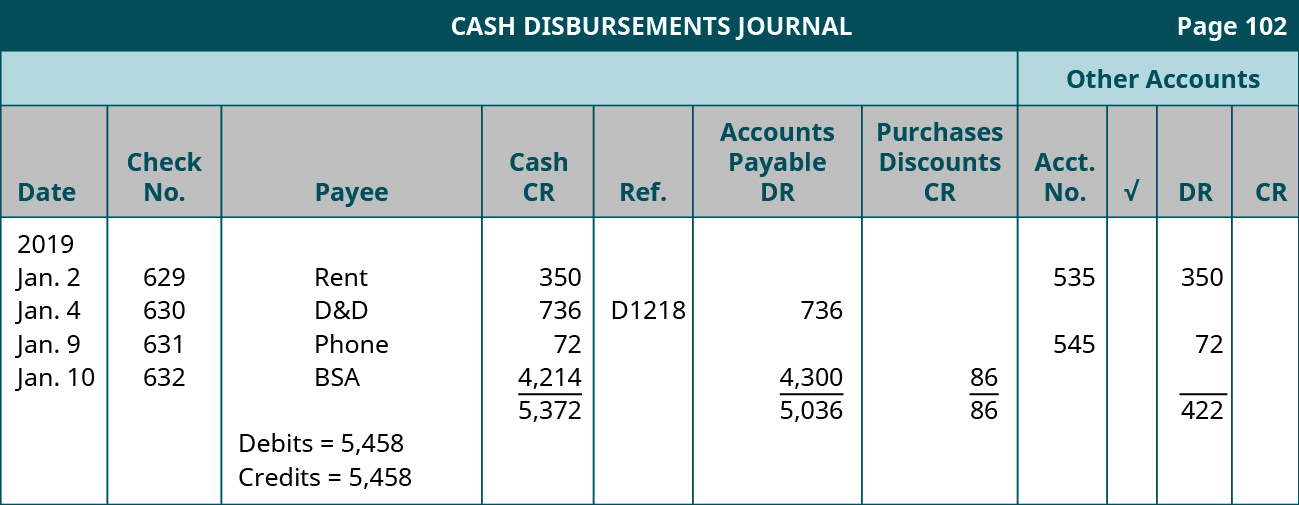
Explanation:
| Jan. 2 | Rent for the month is paid. |
| Jan. 4 | Payment is made for inventory purchased on account in a prior month. |
| Jan. 9 | Paid the telephone bill. |
| Jan. 10 | Paid for inventory purchased earlier on account. The payment arrangement had credit terms; the invoice was paid within the time allowed, and the discount was taken. |

Explanation:
| Jan. 6 | Inventory is purchased on account. |
| Jan. 20 | Inventory is purchased on account. |
At the end of the month, each of the previous journal totals are posted to the appropriate account in the general ledger, and any individual account postings, such as to Rent Expense (Jan. 2 transaction) would also be posted to the general ledger. Note that each account used by the company has its own account section in the general ledger.
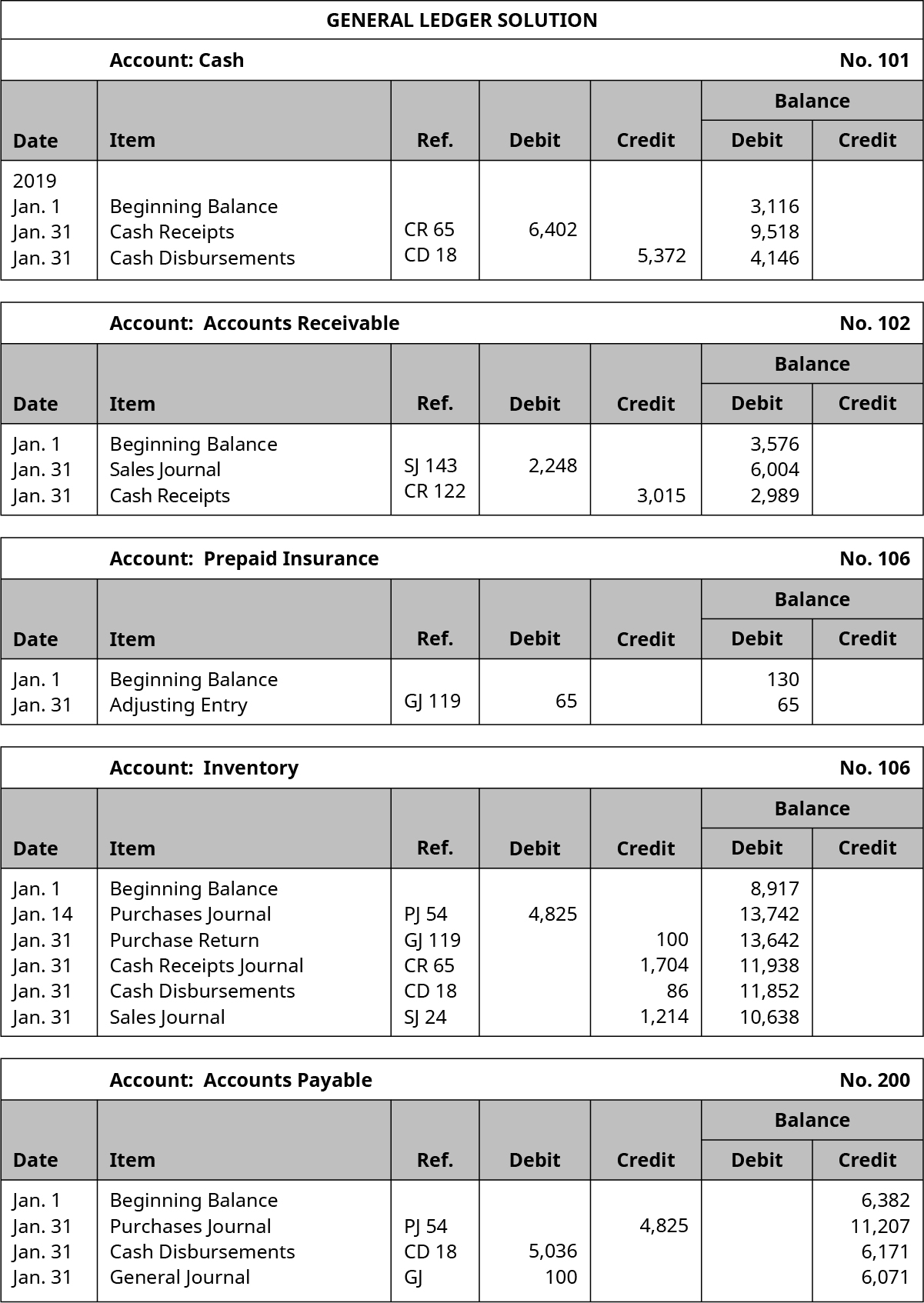
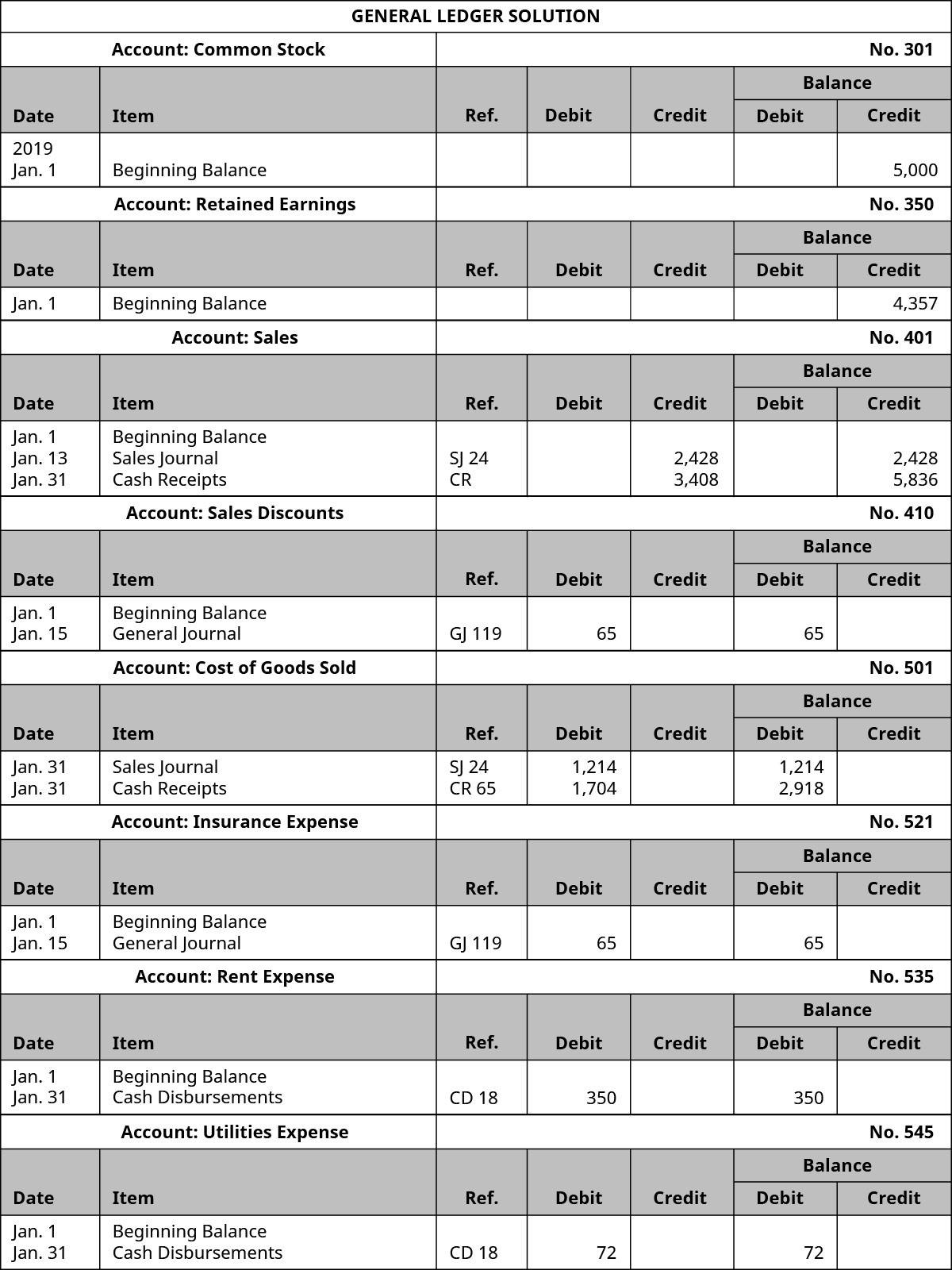
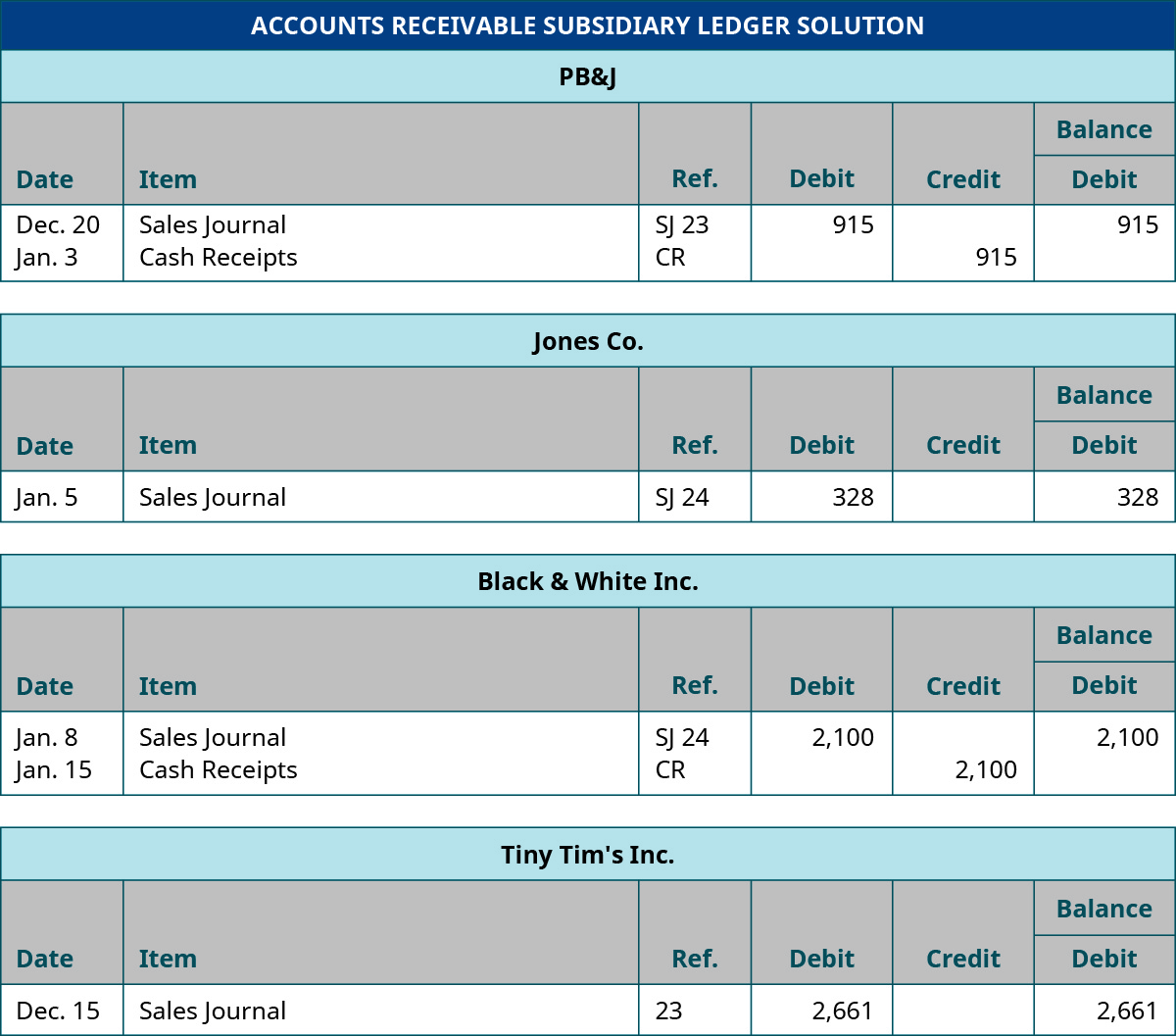
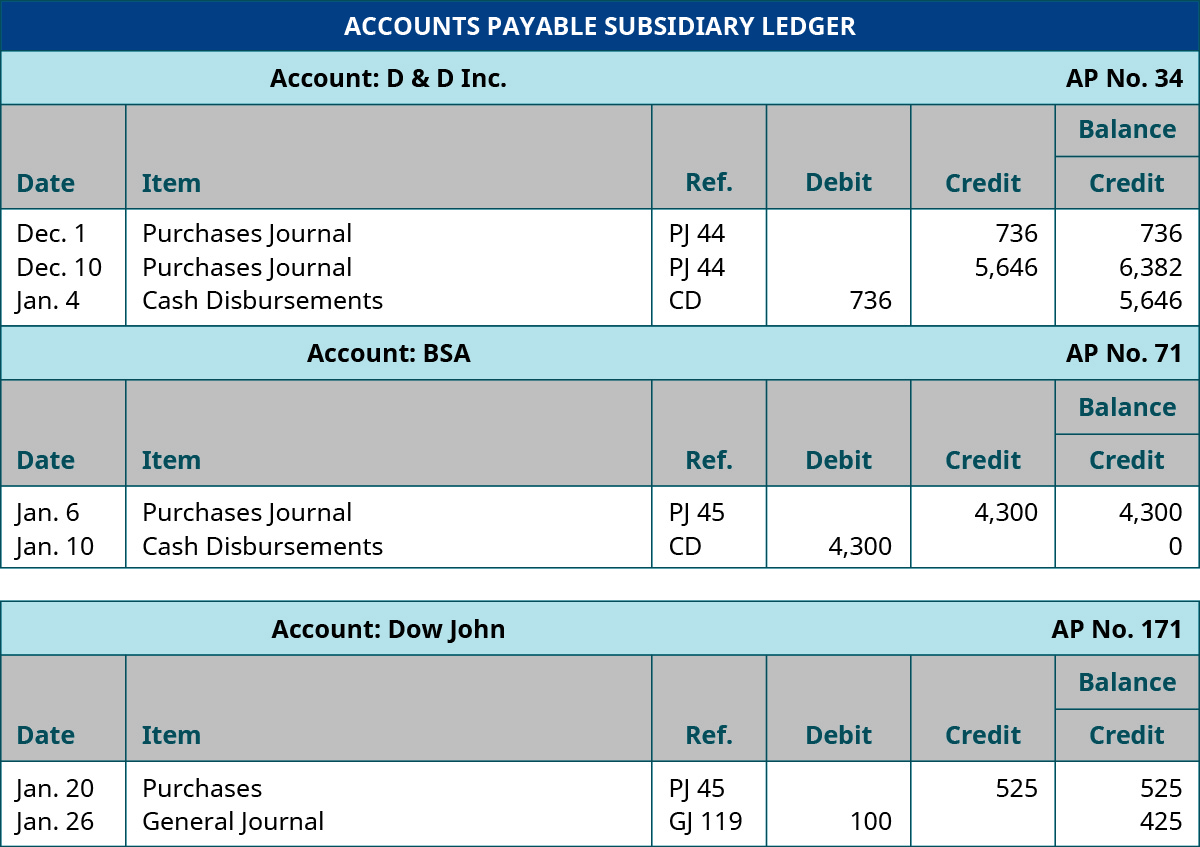

If you check Accounts Receivable in the general ledger, you see the balance is $2,989, and the balance in Accounts Payable is $6,071. If the numbers did not match, we would have to find out where the error was and then fix it.
The purpose of keeping subsidiary ledgers is for accuracy and efficiency. They aid us in keeping accurate records. Since the total of the accounts receivable subsidiary ledger must agree with the balance shown in the accounts receivable general ledger account, the system helps us find mistakes. Since bookkeeping using ledgers is older than the United States, it was an ingenious way to double-check without having to actually do everything twice. It provided an internal control over record keeping. Today, computerized accounting information systems use the same method to store and total amounts, but it takes a lot less time.
Key Concepts and Summary
- A schedule of accounts receivable is a list of all individual accounts and balances that make up accounts receivable.
- A schedule of accounts payable is a list of all individual accounts and balances that make up accounts payable.
Questions
(Figure)Which special journals also require an entry to a subsidiary ledger?
Any special journal can require an entry to the subsidiary ledger if the entry involves accounts receivable or accounts payable.
(Figure)What is a schedule of accounts receivable?
(Figure)How often do we post the cash column in the cash receipts journal to the subsidiary ledger?
The cash column is not posted to the subsidiary ledger. Only the accounts receivable and accounts payable columns are posted to the subsidiary ledgers.
(Figure)The schedule of accounts payable should equal what?
(Figure)Which amounts do we post daily and which do we post monthly?
Any amounts posted to Accounts Receivable or Accounts Payable should be posted daily (to the subsidiary ledger), and the account totals should be posted monthly. We also post the accounts in the Other Accounts column individually and may post daily or at the end of the month. We post all other total column amounts monthly.
(Figure)Why are special journals used?
(Figure)Name the four main special journals.
The four main special journals are sales journal, purchases journal, cash receipts journal, and cash disbursements journal.
(Figure)A journal entry that requires a debit to Accounts Receivable and a credit to Sales goes in which special journal?
(Figure)The purchase of equipment for cash would be recorded in which special journal?
We would record the purchase of equipment for cash in the cash disbursements journal.
(Figure)Can a sales journal be used to record sales on account and a cash sale? Why or why not?
(Figure)When should entries from the sales journal be posted?
We post entries from the sales journal daily to the accounts receivable subsidiary ledger but monthly to Sales and to the Accounts Receivable general ledger account.
(Figure)We record a sale on account that involves sales tax in which journal?
(Figure)We record purchases of inventory for cash in which journal(s)?
We record purchases of inventory for cash in the cash disbursements journal.
(Figure)Should the purchases journal have a column that is a debit to Accounts Payable?
Exercise Set A
(Figure)Maddie Inc. has the following transactions for its first month of business.
| May 1 | Credit sale to Green Lantern Inc. for $1,999 |
| May 2 | Credit sale to Wonder Woman Inc. for $2,000 |
| May 3 | Credit sale to Flash Inc. for $3,050 |
| May 4 | Received $1,000 on account from Green Lantern Inc. |
| May 5 | Credit sale to Black Panther Inc. for $1,875 |
| May 6 | Received the full amount from Flash Inc. |
- What are the individual account balances, and the total balance, in the accounts receivable subsidiary ledger?
- What is the balance in the accounts receivable general ledger (control) account?
Exercise Set B
(Figure)Piedmont Inc. has the following transactions for its first month of business:
| Jun. 1 | Purchased inventory from Montana Inc. on credit for $4,500 |
| Jun. 2 | Purchased inventory from Payton Inc. on credit for $2,400 |
| Jun. 3 | Purchased inventory from Montana Inc. on credit for $1,800 |
| Jun. 4 | Paid $2,000 on account to Montana Inc. |
| Jun. 8 | Purchased inventory on credit from Taylor Inc. for $2,000 |
| Jun. 9 | Paid Payton |
- What are the individual account balances, and the total balance, in the accounts payable subsidiary ledger?
- What is the balance in the Accounts Payable general ledger account?
Problem Set A
(Figure)Evie Inc. has the following transactions during its first month of business. Journalize the transactions that go in the sales journal.
| Jun. 1 | Credit sale (invoice #1) to Green Lantern Inc. (acc #101) for $1,999 |
| Jun. 2 | Credit sale (invoice #2) to Wonder Woman Inc. (acc #102) for $2,000 |
| Jun. 3 | Credit sale to Flash Inc. (invoice #3) (acc #103) for $3,050 |
| Jun. 4 | Received $1,000 on account from Green Lantern Inc. |
| Jun. 5 | Credit sale (invoice #4) to Black Panther Inc. (acc #104) for $1,875 |
| Jun. 6 | Received the full amount from Flash Inc. |
(Figure)The following transactions occurred for Donaldson Inc. during the month of July.
| Jul. 1 | Sold 50 items to Palm Springs Inc. and offered terms of 2/10, n/30, $4,000 on July 1, and issued invoice #12 on account number #312 |
| Jul. 5 | Sold 20 thing-a-jigs to Miami Inc. for $2,150 cash on July 5, and issued invoice #13 |
| Jul. 8 | Sold 30 what-is to Smith Mfg. for $5,000 and offered terms of 2/10, n/30; issued invoice #14 on account number #178 |
| Jul. 9 | Received payment from Palm Springs Inc. |
| Jul. 22 | Received payment from Smith Mfg. after expiration of the discount period |
- Record the transactions for Donaldson Inc. in the proper special journal and subsidiary ledger.
- Record the same transactions using QuickBooks, and print the journals and subsidiary ledger. They should match.
(Figure)Use the journals and ledgers that follow. Total the journals. Post the transactions to the subsidiary ledger and (using T-accounts) to the general ledger accounts. Then prepare a schedule of accounts receivable.


(Figure)Brown Inc. records purchases in a purchases journal and purchase returns in the general journal. Record the following transactions using a purchases journal, a general journal, and an accounts payable subsidiary ledger. The company uses the periodic method of accounting for inventory.
| Oct. 1 | Purchased inventory on account from Price Inc. for $2,000 |
| Oct. 1 | Purchased inventory on account from Cabrera Inc. for $3,000 |
| Oct. 8 | Returned half of the inventory to Price Inc. |
| Oct. 9 | Purchased inventory on account from Price Inc. for $4,200 |
Problem Set B
(Figure)Piedmont Inc. has the following transactions for the month of July.
| Jul. 1 | Sold merchandise for $4,000 to Pinetop Inc. (account number PT152) and offered terms of 1/10, n/30, on July 1, invoice # 1101 |
| Jul. 5 | Sold merchandise to Sherwood Inc. (account number SH 224), Invoice # 1102 for $2,450 cash on July 5 |
| Jul. 9 | Sold merchandise, invoice #1103, to Cardinal Inc. (account number CA 118) for $5,000, and offered terms of 3/10, n/30 |
| Jul. 9 | Received payment from Pinetop Inc. |
| Jul. 22 | Received payment from Cardinal Inc. after expiration of the discount period |
| Jul. 30 | Received a refund check in the amount of $120 from the insurance company (credit Insurance Expense, account number 504) |
- Record the transactions for Piedmont Inc. in the proper special journal, and post them to the subsidiary ledger and general ledger account.
- Record the same transactions using QuickBooks, and print the special journals and subsidiary and general ledger. Your solution done manually should match your solution using QuickBooks.
(Figure)Use the journals and ledgers that follow. Total and rule (draw a line under the column of numbers) the journals. Post the transactions to the subsidiary ledger and (using T-accounts) to the general ledger accounts. Then prepare a schedule of Accounts Payable.


(Figure)Comprehensive Problem: Manual Accounting Information System versus QuickBooks
The following problem is a comprehensive problem requiring you to complete all of the steps in the accounting cycle, first manually and then by entering the same transactions and performing the same steps using QuickBooks. This will demonstrate the important point that a manual accounting information system (AIS) and a computerized AIS both allow the user to perform the same steps in the accounting cycle, but they are done differently.
In a manual system, every step must be performed by the user. In contrast to this, in a computerized system, for each transaction, the user determines the type of transaction it is and enters it in the appropriate data entry screen. The computer then automatically places the transactions in transaction files (the equivalent of journals in a manual system). The user then instructs the system to post the transaction to the subsidiary ledger and at the end of the month to the general ledger. The computer can do the posting automatically.
Other steps done automatically by the computer are preparing a trial balance, closing entries, and generating financial statements. The user would have to provide the computer with information about adjusting entries at the end of the period. Some adjusting entries can be set up to be done automatically every month, but not all. When we say the computer can do a specific step “automatically,” this presumes that a programmer wrote the programs (i.e., detailed step-by-step instructions in a computer language) that tell the computer how to do the task. The computer can then follow those instructions and do it “automatically” without human intervention.
Problem
Assume there is a small shoe store in your neighborhood with a single owner. The owner started the business on December 1, 2018, and sells two types of shoes: a comfortable sneaker that is something athletes would purchase, and a comfortable dress shoe that looks dressy but has the comfort of a sneaker. The name of the business is The Shoe Horn. Complete tasks A and B that follow, using the detailed instructions for each. Following is a list of all transactions that occurred during December 2018.
| a. | Dec. 1 | Jack Simmons, the owner contributed a $500,000 check from his personal account, which he deposited into an account opened in the name of the business, to start the business. |
| b. | Dec. 1 | He rented space that had previously been used by a shoe store and wrote check no. 100 for $9,000 for the first six month’s rent. |
| c. | Dec. 2 | He paid for installation and phone usage $300 (check no. 101) |
| d. | Dec. 2 | He paid for advertising in the local paper $150 (check no. 102). The ads will all run in December. |
| e. | Dec. 2 | He purchased $500 of office supplies (check no. 103) |
| f. | Dec. 3 | He paid $300 for insurance for three months (December 2018, January and February 2019 using check no, 104). |
| g. | Dec. 4 | He purchased 800 pairs of sneakers at $40 a pair– on account from Nike (using purchase order no. 301). Payment terms were 2/10, net 30. Assume the shoe store uses the perpetual inventory system. |
| h. | Dec. 5 | He purchased 500 pairs of dress shoes from Footwear Corp. on account for $20 a pair (using purchase order no. 302). Payment terms were 2/10, net 30 |
| i. | Dec. 10 | He made a sale on account of 20 pairs of sneakers at $100 a pair, to a local University – Highland University (sales invoice number 2000) for their basketball team. Payment terms were 2/10 net 30. |
| j. | Dec. 11 | He made a sale on account of 2 pairs of dress shoes at $50 a pair (sales invoice no. 2001) to a local charity, U.S. Veterans, that intended to raffle them off at one of their events. |
| k. | Dec. 12 | He made a sale on account to The Jenson Group of 300 pairs of dress shoes at $50 a pair, to use as part of an employee uniform. Payment terms were 2/10 net 30. |
| l. | Dec. 14 | He made a cash sale for 2 sneakers at $120 each and 1 pair of shoes for $60. |
| m. | Dec. 14 | He paid the amount owed to Footwear Corp (check no 105) |
| n. | Dec. 17 | Highland University returned 2 pairs of sneakers they had previously purchased on account. |
| o. | Dec. 18 | He received a check from Highland University in full payment of their balance. |
| p. | Dec. 20 | He made a cash sale to Charles Wilson of three pairs of sneakers at $120 each and 1 pair of dress shoes at $60. |
| q. | Dec. 20 | He made a partial payment to Nike for $20,000 (check number 106) |
| r. | Dec. 23 | Received a $400 utility bill which will be paid in January. |
| s. | Dec. 27 | Received a check from The Jenson Group in the amount of $9,000. |
| t. | Dec. 28 | He paid $2,000 of his balance to Nike (check number 107) |
- Enter all of the transactions and complete all of the steps in the accounting cycle assuming a manual system. Follow the steps to be performed using a manual system.
- Enter the transactions into QuickBooks, complete all of the steps in the accounting cycle, and generate the same reports (journals trial balances, ledgers, financial statements). Follow the steps to be performed using a manual system. Follow the steps to be performed using QuickBooks.
Steps to be performed using a manual system
- For each of the transactions listed for the month of December 2018, identify the journal to which the entry should be recorded. Your possible choices are as follows: general journal (GJ), cash receipts journal (CR), cash disbursements journal (CD), sales journal (SJ), or purchases journal (PJ). Templates for the journals and ledgers have been provided.
- Enter each transaction in the appropriate journal using the format provided.


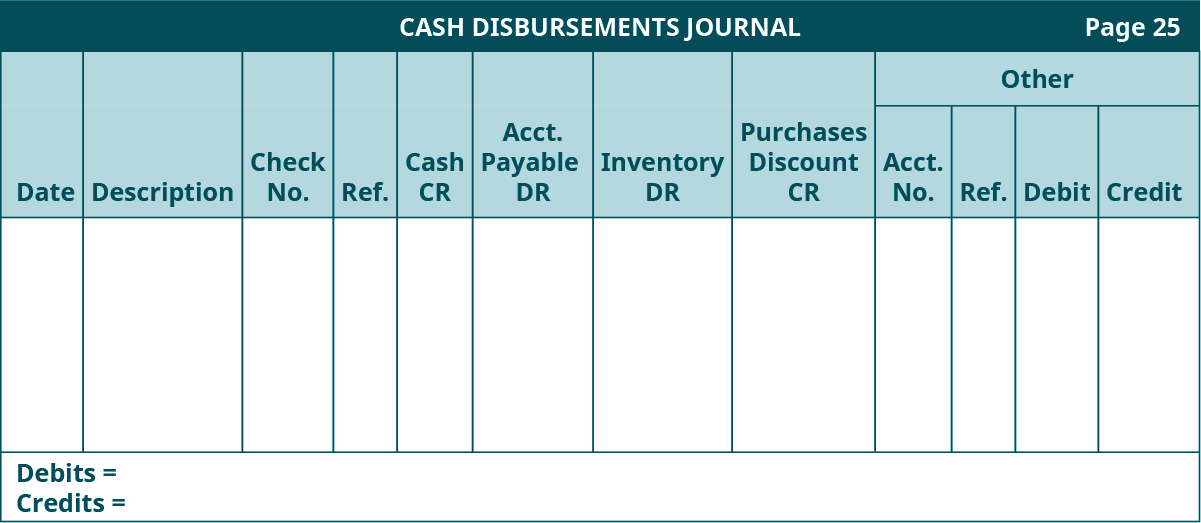
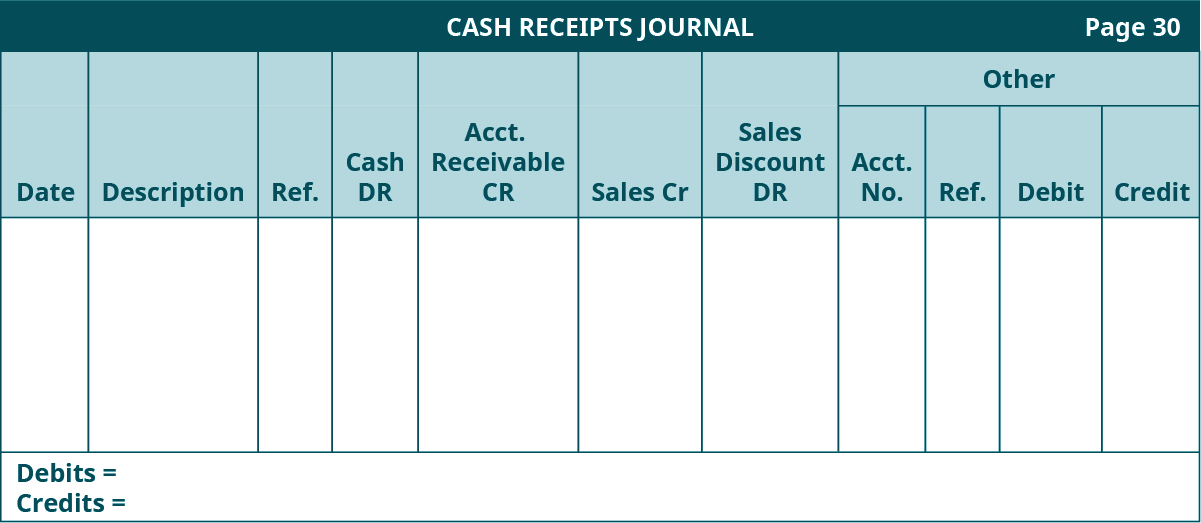
- Open up Accounts Receivable subsidiary ledger accounts for customers and Accounts Payable subsidiary ledger accounts for vendors using the format provided. Post each entry to the appropriate subsidiary ledger on the date the transaction occurred.
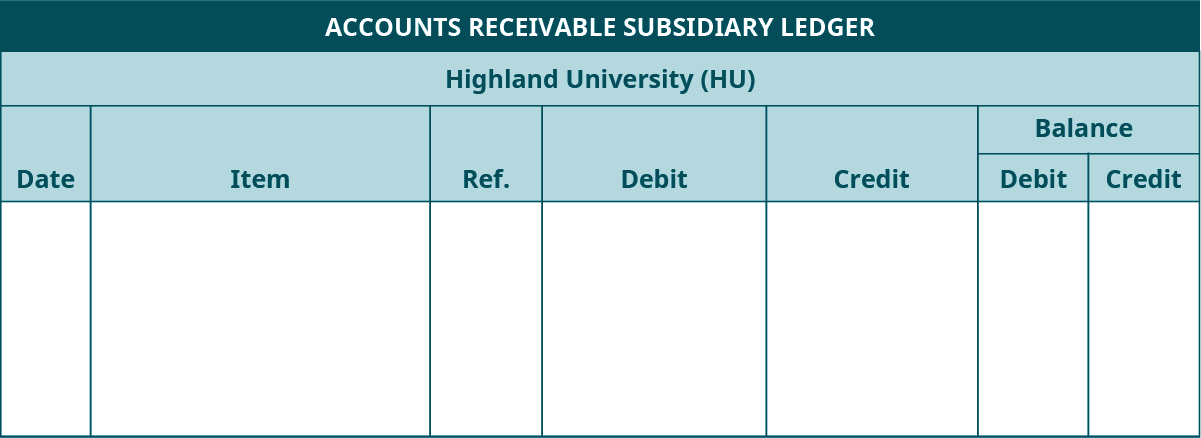




- Total the four special journals, and post from all of them to the general ledger on the last day of December. You should open ledger accounts for the following accounts:
- Cash
- Accounts Receivable
- Merchandise Inventory
- Prepaid Insurance
- Prepaid Rent
- Office Supplies
- Accounts Payable
- Purchases Discounts
- Utilities Expense Payable
- Jack Simmons, Capital
- Sales
- Sales Returns and Allowances
- Sales Discounts
- Cost of Goods Sold
- Rent Expense
- Advertising Expense
- Telephone Expense
- Utilities Expense
- Office Supplies Expense
- Insurance Expense


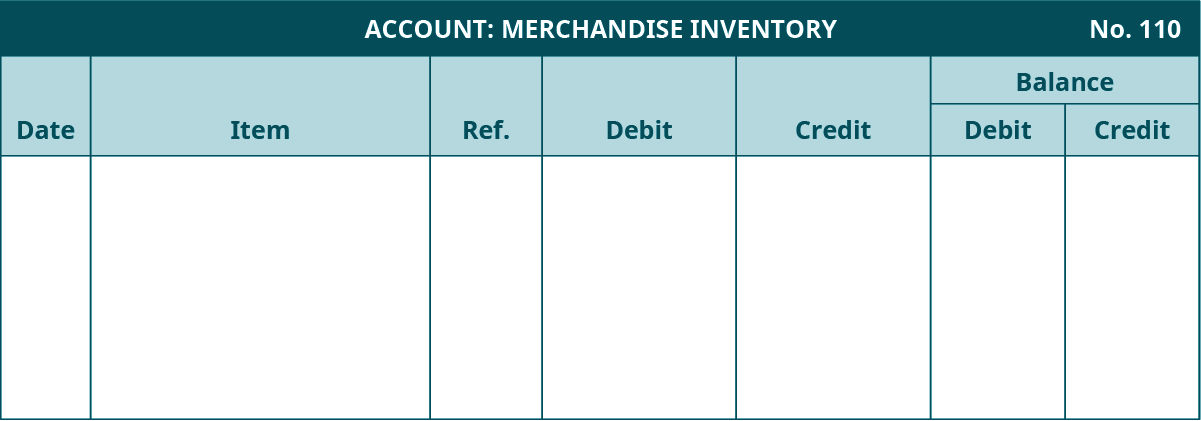

















- Compute balances for each general ledger account and for each Accounts Receivable and Accounts Payable subsidiary ledger account.
- Prepare a trial balance.
- Prepare an accounts receivable schedule and an accounts payable schedule.
- Prepare adjusting journal entries based on the following information given, record the entries in the appropriate journal, and post the entries.
- There were $100 worth of office supplies remaining at the end of December.
- Make an adjusting entry relative to insurance.
- There was an additional bill received in the mail for utilities expense for the month of December in the amount of $100 that is due by January 10, 2019. Jack Simmons intends to pay it in January.

- Prepare an adjusted trial balance
- Prepare closing journal entries, record them in the general journal, and post them.

- Prepare an Income statement, Statement of Owner’s Equity, and Balance Sheet.
Steps to be performed using QuickBooks. You can access a trial version of QuickBooks (https://quickbooks.intuit.com/pricing/) to work through this problem.
- Set up a new company called The Shoe Horn using easy step interview.
- You will be adding a bank account, customizing preferences, adding customers, adding vendors, adding products, and customizing the chart of accounts. You will not need to enter opening adjustments since you are entering transactions for a new company, so there are no opening balances. QuickBooks should automatically create a chart of accounts, but you can customize it, and you will need to enter information for a customer list, vendor list, and (inventory) items list.
- Use “QB transactions” to enter each of the following transactions for the month of December 2018. You can use Onscreen Journal to enter transactions into the general journal, and Onscreen Forms to enter transactions that will end up in the special journals. Identify the type of transaction it is: a sale, a purchase, a receipt of cash, or a payment by check. The categories QuickBooks uses are banking and credit card, customers and sales, vendors and expenses, employees and payroll (not needed in this problem), and other. Note: there is no need to identify the journal as in a manual system or to enter a journal entry, because in an AIS like QuickBooks, you enter the transaction information, and behind the scenes, QuickBooks creates a journal entry that gets added to a transaction file (the equivalent of a journal). After the transactions for the month have been entered, you can print out each of the five journals.
- Enter the following transactions using the appropriate data entry screens based on the type of transaction it is, as identified in step 3.
a. Dec. 1 Jack Simmons, the owner contributed a $500,000 check from his personal account, which he deposited into an account opened in the name of the business, to start the business. b. Dec. 1 He rented space that had previously been used by a shoe store and wrote check no. 100 for $9,000 for the first six month’s rent. c. Dec. 2 He paid for installation and phone usage $300 (check no. 101) d. Dec. 2 He paid for advertising in the local paper $150 (check no. 102). The ads will all run in December. e. Dec. 2 He purchased $500 of office supplies (check no. 103) f. Dec. 3 He paid $300 for insurance for three months (December 2018, January and February 2019 using check no, 104). g. Dec. 4 He purchased 800 pairs of sneakers at $40 a pair– on account from Nike (using purchase order no. 301). Payment terms were 2/10, net 30. Assume the shoe store uses the perpetual inventory system. h. Dec. 5 He purchased 500 pairs of dress shoes from Footwear Corp. on account for $20 a pair (using purchase order no. 302). Payment terms were 2/10, net 30 i. Dec. 10 He made a sale on account of 20 pairs of sneakers at $100 a pair, to a local University – Highland University (sales invoice number 2000) for their basketball team. Payment terms were 2/10 net 30. j. Dec. 11 He made a sale on account of 2 pairs of dress shoes at $50 a pair (sales invoice no. 2001) to a local charity, U.S. Veterans, that intended to raffle them off at one of their events. k. Dec. 12 He made a sale on account to The Jenson Group of 300 pairs of dress shoes at $50 a pair, to use as part of an employee uniform. Payment terms were 2/10 net 30. l. Dec. 14 He made a cash sale for 2 sneakers at $120 each and 1 pair of shoes for $60. m. Dec. 14 He paid the amount owed to Footwear Corp (check no 105) n. Dec. 17 Highland University returned 2 pairs of sneakers they had previously purchased on account. o. Dec. 18 He received a check from Highland University in full payment of their balance. p. Dec. 20 He made a cash sale to Charles Wilson of three pairs of sneakers at $120 each and 1 pair of dress shoes at $60. q. Dec. 20 He made a partial payment to Nike for $20,000 (check number 106) r. Dec. 23 Received a $400 utility bill which will be paid in January. s. Dec. 27 Received a check from The Jenson Group in the amount of $9,000. t. Dec. 28 He paid $2,000 of his balance to Nike (check number 107) - Generate and print a trial balance. Use QB reports to print this and other reports.
- Prepare and enter adjusting entries based on the following information given, and print them.
- There were $100 worth of office supplies remaining at the end of December.
- Make an adjusting entry relative to insurance
- There was an additional bill received in the mail for utilities expense for the month of December in the amount of $100 that is due by January 10, 2019. Jack Simmons intends to pay it in January.
- Generate and print an adjusted trial balance.
- QuickBooks will automatically prepare closing journal entries.
- Print the financial statements: the Income Statement (same as Profit and Loss Statement) and the Balance Sheet.
- Print all of the five journals. After the transactions for the month have been entered, you can print out each of the five journals (general journal, cash receipts journal, cash disbursements journal, sales journal, purchases journal).
- Print the general ledger and the accounts receivable and accounts payable subsidiary ledgers.
- Compare the items you printed from QuickBooks to what you have manually prepared. The content should be identical, although the format may be slightly different. Note: while the results are the same, the QuickBooks software did many of the steps for you automatically.
Glossary
- schedule of accounts payable
- table showing each amount owed and to whom it must be paid; total of the schedule should equal the total of accounts payable in the general ledger
- schedule of accounts receivable
- table showing each customer and the amount owed; total of the schedule should equal the total of accounts receivable in the general ledger

